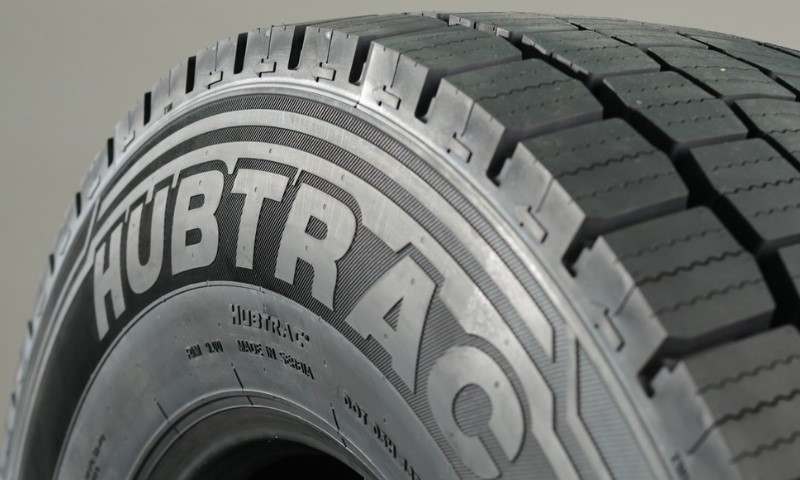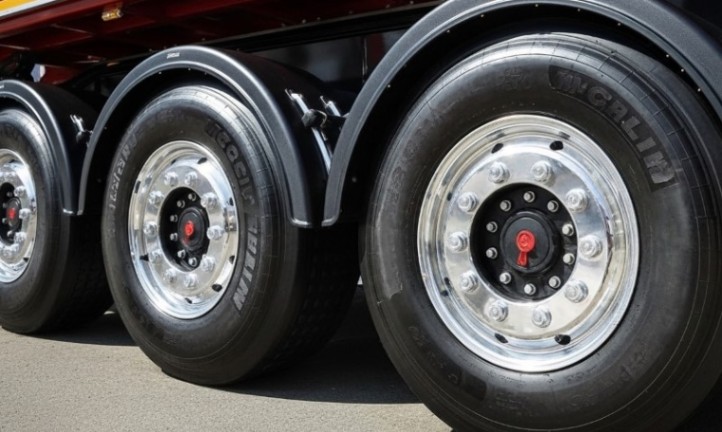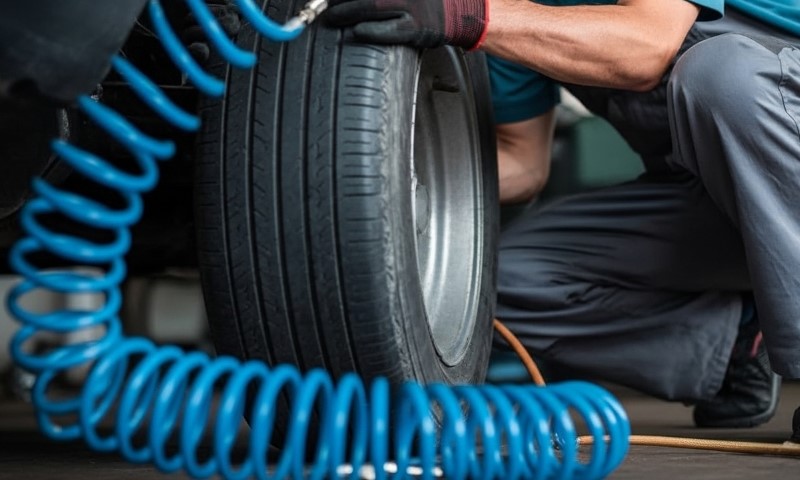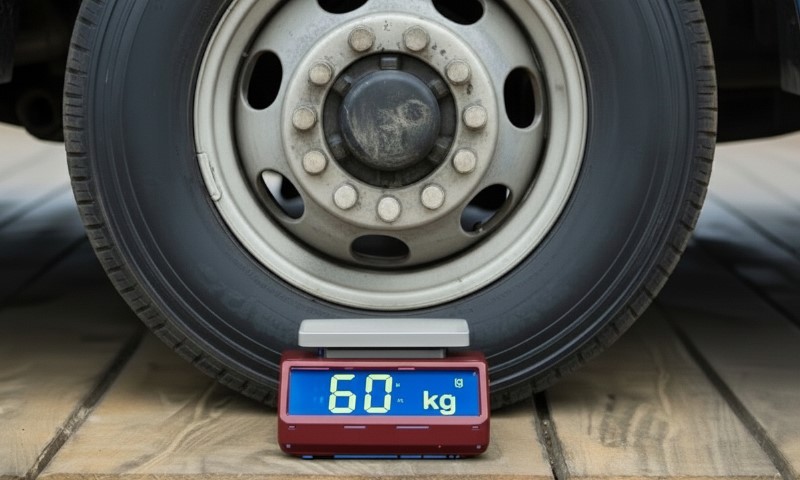If you’ve ever tried to lift a modern truck tire, you already know the answer is “a lot.” But how much exactly? For long-haul LKW (Lastkraftwagen) operations across Europe, and especially for Austrian fleets watching their payloads, toll classes, and fuel costs, tire mass plays a surprisingly large role in everyday economics.
The short answer: a modern European truck tire for a 22.5-inch rim typically weighs between 55 and 70 kilograms. Academic studies, EU environmental datasets, and industry waste management references use those numbers as realistic benchmarks for heavy-duty applications.
Add the wheel, and the total per corner jumps into the 80-110 kg range, depending on whether you’re running aluminum or steel.
But there’s more to the story. Tire weight connects directly to payload limits, emissions, safety, and even recycling logistics. Let’s break down what those kilograms mean in practice.
Tire Weight Importance for European Trucks
Each truck tire represents a carefully engineered balance of load-carrying strength, heat resistance, and rolling efficiency. The mass that makes them strong also affects everything else on the road.
Payload and Vehicle Weight
Every kilogram your tire adds is one you can’t dedicate to cargo. A typical 4×2 tractor with a tri-axle trailer rolls on 12 tires. At 60 kg each, that’s 720 kg in tires alone, before wheels.
Add another 23 kg for aluminum wheels or 40 kg for steel, and you’re looking at 1.0 to 1.2 tonnes of rotating assemblies just to hold up the rig.
That mass affects gross combination weight under EU rules. According to Mobilità Futura, most international freight operates at 40 tonnes GVW, though Austria allows 44 tonnes for certain domestic and cross-border trips. The weight of your tire and wheel assemblies determines how close you ride to that cap.
Fuel Use and CO₂ Output
Heavier tires increase the rotational inertia of the vehicle; it takes more energy to get them moving. Combine that with rolling resistance, and you have a clear fuel penalty.
EU studies show that improved tire design and inflation practices can cut fuel consumption by up to 5%, depending on route and speed.
While tire mass alone doesn’t define efficiency, it’s a factor. Lower unsprung mass helps braking and acceleration, and aluminum wheels can trim a few hundred kilograms from the vehicle, which is an advantage over long distances.
Maintenance, Safety, and Handling
Each tire can weigh up to 70 kg, and the wheel another 30-40 kg. That’s a serious load for anyone in the workshop. Safe handling means:
- Using wheel lifts or dollies rated for 120 kg or more
- Storing tires below shoulder height
- Following proper torque sequences and safety gear protocols
For Austrian fleets operating on alpine routes, where brake heat and downhill torque stress every component, managing that mass safely is part of daily maintenance discipline.
End-of-Life Tire (ELT) Logistics
When tires reach the end of their service life, those same kilograms determine collection fees, transport weight, and recycling costs.
EU and Basel Convention documents estimate 53–60 kg per used truck tire, values used for recycling calculations across Europe.
The Numbers You Can Trust
Tire weights vary slightly across studies, but the accepted reference points are consistent.
Those values frame the practical range seen in workshops: mid-50s to 70 kg, depending on duty type and tire geometry.
Why the Sources Differ
View this post on Instagram
It’s all about context. Tire mass shifts for several good reasons.
Size and Geometry
A 315/80 R22.5 casing carries more material than a 295/80 R22.5, and both are lighter than a wide-base 385/65 R22.5. More rubber and steel cords equal more weight.
Duty Category
Long-haul, regional, and on/off-road tires differ in construction. Construction tires add extra belts, bead protection, and thicker sidewalls, pushing weight upward.
Wear State
A worn tire can lose around 10-12% of its new weight through tread wear. That means a 62 kg tire might weigh just 55 kg when removed for retreading or disposal.
Material Differences
Manufacturers balance cut-resistant rubber, bead bundles, steel cord density, and retreadability, all factors that influence mass.
Heavier doesn’t always mean stronger, but it often signals a more robust structure for high-load or mixed-surface use.
Wheel Mass
When you lift a corner, you’re not just handling the tire. Wheels themselves carry significant mass.
Switching a full 12-wheel rig from steel to aluminum can cut 200-300 kg off the total curb weight.
That’s a meaningful difference for fleets chasing maximum payload or balancing Austrian GO toll cost against revenue.
Rule of thumb:
- Tire + aluminum wheel: 80-95 kg
- Tire + steel wheel: 95-115 kg
Typical Weight by Common European Sizes
Those ranges align with the best available European technical data and environmental modeling values. Always check the product sheet before planning lifts or ordering tools.
Quick Math for Setups
Let’s see how tire weight adds up across entire vehicles.
Standard 4×2 Tractor + 3-Axle Semi (12 tires total)
- 62 kg per tire → 744 kg total tires
- Aluminum wheels (23 kg each) → 276 kg total
- 1,020 kg tire + wheel assemblies
Switch to steel wheels (40 kg each):
- 480 kg total wheel mass
- 1,224 kg assemblies
That’s roughly a 200 kg swing, enough to influence toll classification or payload optimization.
8×4 Construction Rigid
Assume 12 tires with tougher casings (68 kg) and steel wheels (40 kg):
- Tires: 816 kg
- Wheels: 480 kg
- 1,296 kg assemblies
Wide-Base Single Fitment
Replacing duals with wide-base singles can reduce weight and simplify maintenance.
Engineering studies show hundreds of kilograms saved per vehicle, a benefit that can directly translate to payload capacity or specialized equipment allowance.
Always check national axle-load regulations before changing configuration.
How Load Index, Inflation, and Materials Affect Mass
Tire weight reflects how much load a tire is built to carry, the pressure it’s rated for, and the materials inside its carcass. Each of those factors adds or trims kilograms in measurable ways.
Load Index (LI) and Ply Rating
Higher LI values mean the tire must carry more load at a given pressure. That requires stronger carcasses, thicker belts, and reinforced beads, all adding mass.
Two tires of the same size can differ by several kilograms simply due to different load ratings.
Inflation Pressure
Inflation doesn’t change the tire’s physical mass, but the engineering design for high-pressure performance often results in heavier structures.
Compound and Reinforcement
Long-haul linehaul tires optimize for rolling resistance and wear. On/off-road versions add thicker under-tread and extra rubber for puncture resistance. Each design choice adds or subtracts a few kilograms.
Wear Over Time
Truck tires typically lose 10-12% of their mass over their lifespan. A 62 kg tire may weigh about 55 kg at replacement, depending on tread pattern depth and compound hardness. That figure helps recyclers plan for accurate ELT handling weight.
European Regulations
European transport rules don’t just shape how trucks operate, as they influence what tires they roll on.
Axle Loads and Twin-Tyre Rules
European law ties axle loads directly to tire fitment. Drive axles on 44-tonne combinations, for example, are limited to 10.5 tonnes but may require twin tires or road-friendly suspension. More robust casings and dual fitments inevitably add mass; part of staying compliant.
EU Tire Labeling and Efficiency
The EU tire labeling system under Regulation (EU) 2020/740 measures rolling resistance, wet grip, and noise.
While weight doesn’t appear directly on the label, it influences the first parameter. Lightweight casings can reduce rolling resistance, though structural integrity always comes first.
Austrian GO Toll Considerations
Austria’s GO toll applies to all trucks over 3.5 tonnes TPMLM, calculated per kilometer based on emission class and axle count, as per ASFiNAG.
Extra wheel mass contributes to curb weight, affecting the balance between vehicle class and payload. Fleets running alpine routes often favor aluminum wheels on steer and trailer axles to save 150-250 kg without compromising safety.
Workshop Guidance for Austrian Fleets
When weight, safety, and toll costs all intersect, small choices in the workshop can make a big difference. Here’s how Austrian fleets can plan smarter.
1. Estimating Tire and Wheel Mass Without a Data Sheet
| Application | Tire-Only | Add Aluminum Wheel | Add Steel Wheel |
| Long-haul (22.5 in) | 60-65 kg | +23 kg | +40 kg |
| Construction (22.5 in) | 65-70 kg | +23 kg | +40 kg |
Dual assembly on drive axles can total:
- 165-180 kg (aluminum wheels)
- 200-220 kg (steel wheels)
Use those estimates for planning lifting gear capacity and storage racks.
2. Safe Handling Practices
- Always use mechanical aids rated over 120 kg per lift.
- Avoid stacking over two tires high without racks.
- Confirm torque values with wheel manufacturer data.
- Train staff on manual handling under EU occupational safety norms.
3. Fleet Specification Tips for HubTrac Reifen Readers
HubTrac Reifen often works with Austrian transporters who balance payload with durability in alpine and transalpine freight. For those operations:
- Use aluminum wheels on steer and trailer axles to save up to 250 kg.
- Retain steel wheels on drive axles for chain use and quarry access.
- Evaluate wide-base singles only after confirming axle compatibility and national approval.
- Track tire mass and wear loss for accurate environmental and recycling reporting.
FAQs
Key Takeaways
- A typical European heavy truck tire weighs 55–70 kg
- Add 23 kg (aluminum) or 40 kg (steel) for the wheel to estimate mounted weight.
- Expect 80–95 kg (aluminum) or 95–115 kg (steel) total per corner.
- Across a 12-tire tractor-trailer, assemblies total 0–1.2 tonnes.
- Wear reduces mass by about 10–12% over the tire’s life.
- Wheel material and fitment choices alone can shift curb weight by 200–300 kg, which directly affects payload and Austrian GO toll efficiency.



